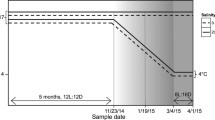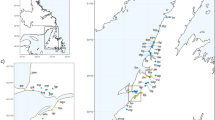Abstract
The preferred temperatures of juvenile three-spined stickleback from bodies of freshwater of the White Sea coastal region are studied under experimental conditions. The final preferred temperature in the young-of-the-year is 15.2°C, regardless of the acclimation temperature (11, 16, and 20°C). The increased duration of experiments (10 days) made it possible to track the process of the temperature selection as a whole, rather than observing its particular phases. A comparison of the original results with the literature data reveal possible differences in the temperature characteristics, both in geographically remote populations of the three-spined stickleback and between its freshwater and marine forms.


Similar content being viewed by others
REFERENCES
Atlas presnovodnykh ryb Rossii (Atlas of Freshwater Fishes of Russia), Moscow: Nauka, 2002, vol. 2.
Golovanov, V.K., Ecophysiological patterns of distribution and behavior of freshwater fish in thermal gradients, J. Ichthyol., 2013, vol. 53, no. 4, pp. 252–280.
Ivlev, V.S., Elements of physiological hydrobiology, in Fiziologiya morskikh zhivotnykh (Physiology of Marine Animals), Moscow: Nauka, 1966, pp. 3–45.
Lapkin, V.V., Svirskii, A.M., and Sopov, Yu.N., Chosen temperature and acclimation temperature of fish, Zool. Zh., 1979, vol. 58, no. 11, pp. 1659–1670.
Ozernyuk, N.D., Temperaturnye adaptatsii (Temperature Adaptations), Moscow: Mosk. Univ., 2000.
Svirskii, A.M., Fish behavior under heterothermal conditions, in Doklady 2-go Vserosiiskogo soveshchaniya “Povedenie i raspredelenie ryb” (Proc. 2nd All-Russia Conf. “Fish Behavior and Distribution”), Borok, 1996, pp. 140–152.
Svirskii, A.M. and Golovanov, V.K., Effect of acclimation temperature on thermoregulation behavior of immature bream Abramis brama (L.) in different seasons, Vopr. Ikhtiol., 1991, vol. 31, no. 6, pp. 974–980.
Smirnov, A.K., Effect of the presence of food in the optimum temperature zone on the behavior of immature perch Perca fluviatilis L., Vestn. Astrakhan. Gos. Tekh. Univ., Ser. Rybn. Khoz., 2013, no. 1, pp. 75–82.
Khlebovich, V.V., Akklimatsiya zhivotnykh organizmov (Acclimation of Animal Organisms), Leningrad: Nauka, 1981.
Shilov, I.A., Ekologiya (Ecology), Moscow: Vysshaya Shkola, 2001.
Bicego, K.C., Barros, R.C.H., and Branco, L.G.S., Physiology of temperature regulation: comparative aspects, Comp. Biochem. Physiol., Part A: Mol. Integr. Physiol., 2007, vol. 147, pp. 616–639.
Fry, F.E.J., Effect of the Environment on Animal Activity, Univ. Toronto Studies, Biol. Ser., Publ. Ont. Fish. Res. Lab., 1947, no. 68.
Garside, E.T., Heinze, D.G., and Barbour, S.E., Thermal preference in relation to salinity in the threespine stickleback, Gasterosteus aculeatus L., with an interpretation of its significance, Can. J. Zool., 1977, vol. 55, no. 3, pp. 590–594.
Jobling, M., Temperature tolerance and the final preferendum—rapid methods for the assessment of optimum growth temperatures, J. Fish. Biol., 1981, vol. 19, pp. 439–455.
Jordan, C.M. and Garside, E.T., Upper lethal temperatures of threespine stickleback, Gasterosteus aculeatus (L.) in relation to thermal and osmotic acclimation, ambient salinity, and size, Can. J. Zool., 1972, vol. 50, pp. 1405–1411.
Lachance, S., Magnan, P., and Fitz Gerald, G.J., Temperature preferences of three sympatric sticklebacks (Gasterosteidae), Can. J. Zool., 1987, vol. 65, no. 6, pp. 1573–1576.
Reynolds, W.W. and Casterlin, M.E., Behavioral thermoregulation and the “final preferendum” paradigm, in Thermoregulation in Ectotherms. Symp. Richmond, 1978, Am. Zool., 1979, vol. 19, no. 1, pp. 211–224.
Røed, K.H., The temperature preference of the three-spined stickleback, Gasterosteus aculeatus L. (Pisces), collected at different seasons, Sarsia, 1979, vol. 64, pp. 137–141.
ACKNOWLEDGMENTS
We are grateful to A.A. Bolotovskii for providing the live material for research.
This work was performed as part of State Task no. AAAA-A18-118012690102-9 with support from the Presidium of the Russian Academy of Sciences: Theme no. 0122-2018-0001.
Author information
Authors and Affiliations
Corresponding author
Ethics declarations
Conflict of interests. The authors declare that they have no conflict of interest.
Statement on the welfare of animals. All applicable international, national, and/or institutional guidelines for the care and use of animals were followed.
Additional information
Translated by D. Martynova
Rights and permissions
About this article
Cite this article
Smirnov, A.K., Smirnova, E.S. Final Preferred Temperature of Juvenile Three-Spined Stickleback Gasterosteus aculeatus (Linnaeus, 1758). Inland Water Biol 12, 83–87 (2019). https://doi.org/10.1134/S199508291901019X
Received:
Revised:
Accepted:
Published:
Issue Date:
DOI: https://doi.org/10.1134/S199508291901019X




